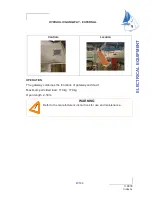
800.635.5202 | nrs.com |
5
sunlight. Whether transporting your boat inflated or deflated, make sure to inspect the load
for any areas that could rub, abrade or puncture the boat’s fabric. Remember that any sand
or other debris left in the boat could cause wear on the fabric during transport. Putting your
deflated boat in the boat bag for transport will help prevent wear and damage from other
gear.
STORAGE
Let the Drifter dry thoroughly before deflating it. Do not use a vacuum or deflator to suck
all the air out of the chambers unless absolutely necessary. The ideal storage position is
unfolded in a cool, dry location, with a small amount of air left in the chambers. If space is
limited, store the boat loosely rolled, with the valves open, in a protective bag or cover. Keep
the boat off dirt or concrete floors. Rodents have been known to burrow into stored boats, so
take precautions to prevent this.
If you keep your Drifter on a trailer, cover it when not in use to protect it from sun damage.
Also reduce inflation pressure to prevent accidental overinflation.
CAUTION
Safety Warning
Paddlesports can be dangerous and physically demanding. Participating in paddlesports may
cause serious injury or death. Follow these safety standards when using this product:
• Get instruction and First Aid training. Carry First Aid and rescue equipment.
• Always wear a Coast Guard Approved Personal Flotation Device. Dress for cold water
and weather as appropriate to guard against hypothermia.
• Check your equipment prior to each use for signs of wear or failure. Do not impair entry
or exit.
• Never boat alone. Scout unfamiliar waters. Portage where appropriate. Do not exceed
your boating ability.
• Do not boat in high water or flood conditions.
• Read owner’s information booklet prior to using this product.
The user of this product acknowledges both an understanding and an assumption of the risk
involved in paddlesports.


























